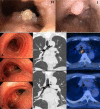Suppression of respiratory papillomatosis with malignant transformation by erlotinib in a kidney transplant recipient
- PMID: 23986124
- PMCID: PMC3761685
- DOI: 10.1136/bcr-2013-008757
Suppression of respiratory papillomatosis with malignant transformation by erlotinib in a kidney transplant recipient
Abstract
A 52-year-old non-smoker and renal transplant recipient developed an incessant cough. A CT scan of the thorax revealed ill-defined hazy opacities in the right upper lung. He was diagnosed with non-tuberculosis Mycobacterium chelonae/abscessus infection based on sputum culture results. A trial of antibiotics initially resulted in some clinical improvement. A subsequent CT of the thorax documented worsening of the lesions in the right lung and new lesions on the left. An intratracheal growth was noted. Bronchoscopy with biopsy of the tracheal lesions documented respiratory papillomatosis with transformation to squamous cell cancer. Test for high-risk human papilloma virus was positive. Video-assisted thoracoscopic surgery biopsy with wedge resection of the left lower lobe revealed metastatic squamous cell lung cancer. He was treated with one ablation followed by four cycles of chemotherapy. He has been maintained on erlotinib ever since. There has been no recurrence of the cough or papillomas.
Figures


Similar articles
-
Recurrent respiratory papillomatosis with lung involvement and malignant transformation.Thorax. 2014 Mar;69(3):302-3. doi: 10.1136/thoraxjnl-2012-202971. Epub 2013 May 24. Thorax. 2014. PMID: 23709759 No abstract available.
-
Lung squamous cell carcinoma arising in a patient with adult-onset recurrent respiratory papillomatosis.Jpn J Clin Oncol. 2013 Jan;43(1):78-82. doi: 10.1093/jjco/hys179. Epub 2012 Oct 30. Jpn J Clin Oncol. 2013. PMID: 23110763
-
Transformation of Recurrent Respiratory Papillomatosis: Squamous Cell Carcinoma in a Pregnant Teen.Ann Thorac Surg. 2019 Jun;107(6):e403-e404. doi: 10.1016/j.athoracsur.2018.10.047. Epub 2018 Nov 30. Ann Thorac Surg. 2019. PMID: 30508534
-
Malignant transformation of respiratory papillomatosis in a solid-organ transplant patient: case report and literature review.Ann Otol Rhinol Laryngol. 2013 Jul;122(7):457-60. doi: 10.1177/000348941312200708. Ann Otol Rhinol Laryngol. 2013. PMID: 23951698 Review.
-
Recurrent respiratory papillomatosis: A state-of-the-art review.Respir Med. 2017 May;126:116-121. doi: 10.1016/j.rmed.2017.03.030. Epub 2017 Apr 1. Respir Med. 2017. PMID: 28427542 Review.
Cited by
-
Squamous Cell Carcinoma Originating from Adult Laryngeal Papillomatosis: Case Report and Review of the Literature.Case Rep Otolaryngol. 2018 Dec 19;2018:4362162. doi: 10.1155/2018/4362162. eCollection 2018. Case Rep Otolaryngol. 2018. PMID: 30662782 Free PMC article.
-
Epidermal growth factor receptor inhibitor therapy for recurrent respiratory papillomatosis.F1000Res. 2013 Oct 3;2:202. doi: 10.12688/f1000research.2-202.v1. eCollection 2013. F1000Res. 2013. PMID: 24795806 Free PMC article.
References
-
- Mammas IN, Sourvinos G, Spandidos DA. Human papilloma virus (HPV) infection in children and adolescents. Eur Pediatr 2009;2013:267–73 - PubMed
-
- Bishai D, Kashima H, Shah K. The cost of juvenile-onset recurrent respiratory papillomatosis. Arch Otolaryngol Head Neck Surg 2000;2013:935–9 - PubMed
-
- Silver RD, Rimell FL, Adams GL, et al. Diagnosis and management of pulmonary metastasis from recurrent respiratory papillomatosis. Otolaryngol Head Neck Surg 2003;2013:622–9 - PubMed
-
- Castellsague X, Bosch FX, Munoz N. Environmental co-factors in HPV carcinogenesis. Virus Res 2002;2013:191–9 - PubMed
Publication types
MeSH terms
Substances
Supplementary concepts
LinkOut - more resources
Full Text Sources
Other Literature Sources
Medical
